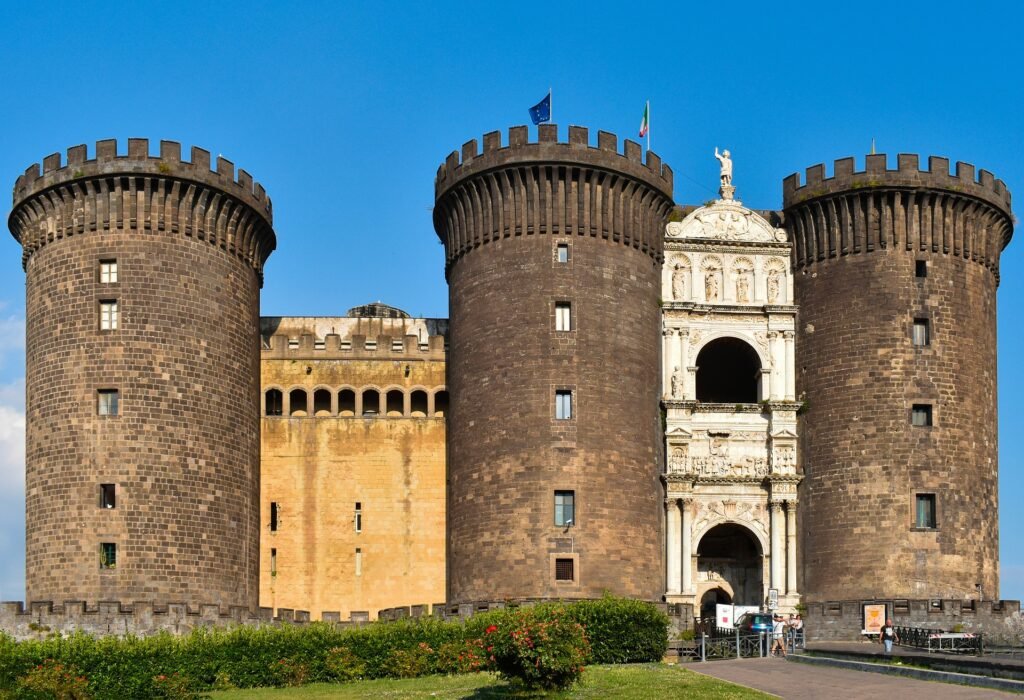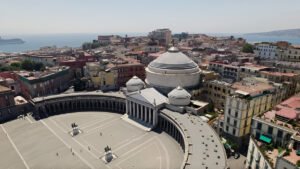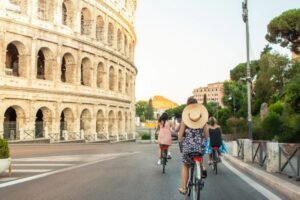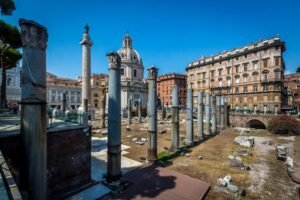10 must-see Castles and Palaces wonders of Italy | discover the top picks

Italy has some of the most extraordinarily beautiful castles and palaces. Wonders of Italy that have seen much history and architectural brilliance. These wonderful archaeological achievements range from medieval castles and palaces Wonders of Italy of Florence to royal opulence embedded in Naples. Castles and palaces Wonders of Italy travel with time with the eyes of visitors peeking through the opening of kings, queens, and noble families.
Castel dell’Ovo (Naples)
Today, we’ll talk about Castel dell’Ovo in Naples. Castel dell’Ovo is the oldest castle in Naples. It is near the port, located on a tuff block surrounded by the sea, called the “Island of Megaride,” which in the past was completely separated from the coast. According to history, this was the place where the ancient Greeks arrived. They were probably the ancestors of the founders of Partenope, the ancient Naples.
In the first century B.C., the Roman consul Lucius Licinius Lucullus built a luxurious villa, remembered as the Castro Lucullanum, which stretched up to Monte Echia. In the mid-5th century, this mansion became the banishment house of the Emperor Romulus Augustulus.
Over the centuries, the castle underwent various adjustments, and it is for this reason that today we can find very little of its original appearance. The real fortress was raised during the Norman period by Ruggero II, after he conquered Naples, and was then expanded by Federico II di Svevia.
New makeovers were ordered by Carlo I d’Angiò between 1270 and 1280 before he decided to build Castel Nuovo. The last and most significant structural revisions took place during the reign of Alfonso V d’Aragona after 1458. But why is this castle called Castel dell’Ovo? This name comes from a legend, according to which the poet Virgilio, who in the Middle Ages was also considered a wizard, hid a magical egg there.
This egg was meant to keep the castle safe forever, and its collapse would have been the origin of a series of calamities for the entire city of Naples. After Italy’s unification, the castle risked demolition due to a project for the creation of a new district, but fortunately, it never came to fruition.
Castel Nuovo (Naples)
In 1279, Charles I of Anjou, now the King of Sicily, had relocated the capital to Naples. He decided to build a grand castle to solidify his power—a fortress like no other, overlooking the sea: Castel Nuovo.
Now, like many medieval buildings that have evolved over the centuries, the same is true for Castel Nuovo, and very little of its 13th-century structure remains. It has endured many changes of hands and numerous invasions throughout its long life, along with many conspiracies. Given that Italy has been invaded more times than a football pitch, this is not surprising.
But I’m no expert on architecture, so I’ll concentrate on the history of the castle rather than speculate. This also isn’t a travel vlog, so here we go—let’s get stuck in!
Charles of Anjou was the son of King Louis of France and Blanche of Castile. The youngest son, initially destined for the Church, Charles abandoned this path for the life of a soldier, even fighting in the Seventh and Eighth Crusades. But his claim to fame was his conquest of the Kingdom of Sicily and Naples, keeping in mind that Italy had yet to be unified as we know it today.
Frederick, the Emperor of the Holy Roman Empire, had a bastard son, Manfred. Manfred controversially usurped the Kingdom of Sicily in 1258, falsely claiming that the four-year-old King Conradin had died when he was very much alive.
Sforza Castle (Milan)
Welcome to one of the largest citadels in all of Europe: the Sforza Castle, here in the heart of Milan. Originally built by the Visconti family in the 14th century, the castle was significantly enlarged in 1450 when Francesco Sforza took over the city, giving it much of the appearance it retains today, including the massive courtyard space you see.
Inside, you’ll find the massive quadrangular courtyard surrounded by four brick walls and four fortified towers. The original gangways, moats, and drawbridges still lead up to the castle’s doors, a testament to the Sforza family’s intention to keep someone out.
While it was Francesco Sforza whose coat of arms featured the ominous image of a viper eating a man, it was his son, Ludovico, who invited great artists from across Italy to decorate the castle. Among them was none other than Leonardo da Vinci, who painted the walls of the Sala delle Asse with a unique style of depicting trees emerging from massive roots, decorating the ceiling with an illusionistic canopy.
In 1550, at the age of 75, Michelangelo abandoned a statue of the Pietà (now located in the Cathedral Museum of Florence) and immediately began work on another Pietà—his last statue, known as the Rondanini Pietà, which is located here in the Sforza Castle in Milan.
So, when you’re in Milan, be sure to stop by and enjoy the incredible art this castle has to offer.
Palazzo Pitti (Florence)
Oltrarno” is the Italian word for “beyond the Arno,” with “Arno” being the name of the river. This entire neighborhood is dominated by one massive structure known as the Pitti Palace.
The building was originally constructed in 1452 for a patron named Luca Pitti. In fact, the original Pitti Palace was significantly smaller than the structure you see today.
When you’re looking at the façade of the Pitti Palace, imagine a vertical axis rising up from the main door, through the window above it, and then through the window above that. Now, add three window bays to the right and three to the left—that was the original width of the Pitti Palace.
In 1549, the Duchess of Florence, Eleonora of Toledo, purchased the building from the Pitti family for the whopping sum of 9,000 florins—a substantial amount of money at the time. More importantly, Eleonora began a sequence of enlargements and additions to the structure, eventually transforming it into the mother of all royal palaces in Europe.
It wasn’t just the palace itself that grew larger; the space behind it expanded as well. Land was purchased from a family named Boboli, and it was gradually transformed into one of the most sumptuous gardens in all of Europe. Over time, the name “Boboli” evolved into “Boboli,” and today, the Boboli Gardens stand as one of the most beloved destinations for tourists and art enthusiasts to experience the natural beauty that makes this city so extraordinary.
Royal Palace of Caserta (Caserta)
Hey everyone! Today, my UNESCO World Heritage Journey takes us to the Royal Palace of Caserta in southern Italy. This incredible palace is located about 20 kilometers north of Naples. Built in the 1750s by King Charles VII of Naples and Sicily, it’s the largest royal palace in the world by volume. It’s absolutely enormous, and there are some beautiful gardens on the other side, so let’s go explore!
As I mentioned, the palace was built in the 1750s by the Kings of Naples. Its location, away from the coastline, was chosen because the royal palace in Naples, situated right on the water, was considered highly vulnerable to attack. Here, in Caserta, there was also plenty of space, which allowed them to construct one of the largest palaces in the world by volume.
The palace is truly massive. The long sides measure 250 meters each, the short sides 200 meters, and it contains an astonishing 1,200 rooms—absolutely enormous!
Now, we’re in the throne room, the grandest and most beautiful room in the entire palace. Everywhere we’ve been on the King’s Floor has been incredible—frescoes on the ceilings, stunning sculptures, glittering chandeliers, luxurious furniture, and marble everywhere. It’s all so sumptuous.
The palace’s design strongly resembles Versailles, showcasing the ultimate expression of Baroque architecture. One fascinating feature is a series of themed rooms, each dedicated to a season. We’ve seen spring, then summer, now we’re in autumn, and the next room is winter. It’s really captivating to see how each room is uniquely styled with different colors and themes.
And of course, what 18th-century palace would be complete without some enormous, beautiful gardens? Caserta is no exception. These gardens are absolutely stunning, and the highlight is, of course, the three-kilometer canal that stretches from the palace, which you can see far in the background.
There are also some breathtaking fountains, and it amazes me that they’re powered entirely by gravity—no electricity, no hydraulics, nothing like that! Unfortunately, we were hoping to explore the English Garden as well, but a big thunderstorm has just rolled in, and we have to leave the park. It’s a bit of a shame.
Palazzo Vecchio (Florence)
On the city’s main square stands the Palazzo Vecchio, Florence’s City Hall. While its exterior is medieval, Michelangelo’s David—this one a replica—seems to welcome you into the Renaissance world and the dawn of our modern age. The elaborate courtyard, with its Roman-inspired decorations, is a textbook example of Renaissance design.
The enormous main hall was designed to impress, accommodating 500 guests at once. In an age before mass media, this was how public opinion was shaped. The art proudly proclaimed the glory of Florence, thanks to the Medici family. The frescoes depict great military victories: Florence defeating Pisa in 1497 and trouncing Siena in 1555.
The ceiling exalts the divine glory of Grand Duke Cosimo de’ Medici. Depicted as an emperor and blessed by the pope, Cosimo was the first Medici to rule as a king. Below him, you see Leo X, the first of three Medici popes, symbolizing the family’s powerful connections in both Rome and heaven. These ties help explain how the Medici became the Vatican’s bankers.
The hall is flanked by statues representing the heroic labors of Hercules, a mortal who became a half-god through his achievements—a parallel not lost on the awe-inspired Florentines. Once again, you’ve got to admire the remarkable legacy of the Medici.
Castello Estense (Ferrara)
Of all the symbols of Ferrara, the castle is undoubtedly the most important. Over time, it has become the defining emblem of the city, thanks in part to a rebellion in 1385. The people of Ferrara revolted against Nicolò II d’Este after he raised taxes excessively. Although Nicolò managed to survive the uprising, he realized that his enemies were not only outside the duchy but, unfortunately, also within the city itself.
To safeguard his rule and ensure the survival of his house, Nicolò decided to build the castle you see behind me. He enlisted the architect responsible for constructing the Gonzaga Castle in Mantua, choosing someone he could trust completely. Nicolò wanted something even grander—a fortress with the largest moat of its time and four imposing towers. The castle was designed for defense, as they anticipated that the Este family might face foreign attacks. However, such an attack never occurred.
Castello di Miramare (Trieste)
I’d like to take you inside one of the rooms that is usually off-limits to the public. Welcome to the Salottino di Carlotta, the little blue living room where Carlotta likely spent some of her happiest moments. Here, she painted, wrote letters, and enjoyed her personal space—her own little world.
Let me introduce you to 22 paintings in this room, one of which holds special significance. It is a portrait of Carlotta, depicted wearing a Brianza costume, typical of Lombardy at the time. This portrait dates back to the period when she and her family resided in Milan. The painting was relocated here as a way to honor the Lombard people.
In another small but charming painting made for Queen Victoria, Carlotta is portrayed at just two years old, wearing a white dress with shades of blue—a delicate and touching depiction. A copy of this painting remains at the English court, but the original became part of the royal couple’s collection and stayed in Belgium, where it belonged to Charlotte’s family.
Looking closely at the back of one of these paintings, we discovered some intriguing details. Not only did we find the autograph signature of the master artist, but also a small inscription referencing His Majesty, S.A.S. Magister Laurent Mer de France, and the Queen of the French. While this does not refer to Charlotte’s mother, who was part of the Belgian court, it almost certainly refers to her grandmother.
Castello Aragonese (Ischia)
And finally, we have Ischia, the largest of the six municipalities on the island. It is divided into two localities: Ischia Porto and Ischia Ponte, which are separated by a couple of kilometers of promenade.
Ischia Porto is the island’s largest center, home to numerous restaurants, bars, shops, and nightclubs. Via Roma is the main shopping street, lined with ancient churches, hotels, and craft shops.
On the other hand, Ischia Ponte is the historic center of Ischia. What leaves everyone in awe is the timeless beauty of the Aragonese Castle.
Built in 474 BC by Hiero, the tyrant of Syracuse, the castle was later fortified by Alfonso I in the fourteenth century. Visitors can climb to the top to explore the remaining fortified buildings and enjoy a breathtaking view of the Gulf of Naples.
And with that, we have come to the end of our journey discovering Ischia. Join me for the next adventure!
Castello di Sammezzano (Tuscany)
The main building is an eclectic structure, predominantly featuring an orientalist style. This is the result of the 19th-century restructuring of a large farm originally built in 1605 at the behest of the Ximenes D’Aragona family. However, the history of the place dates back even further, to the Roman era.
Historian Robert Davidsohn, in his History of Florence, mentions that in 780, Charlemagne may have passed through the area on his return from Rome, where he had his son baptized by the Pope. Over the centuries, the estate to which the castle belongs was owned by several prominent families: the Altoviti, and later, by the order of Duke Cosimo, the property was transferred to Giovanni Jacopo de’ Medici, who eventually sold it to Sebastiano Ximenes.
These assets remained in the Ximenes d’Aragona family until the death of the last heir, Ferdinando, in 1816. In a survey created by engineer Giuseppe Faldi in 1818, the castle is described as a substantial structure with a bastion and an entrance staircase on the opposite side from the current access stairs, which no longer exist today.
Following a lengthy process related to Ferdinando Ximenes’ will, the estate, along with the family name, coat of arms, and titles, was passed to the eldest son of Vittoria, Ferdinando’s sister and the wife of Niccolò Panciatichi. It was later inherited by Ferdinando Panciatichi Ximenes d’Aragona, who redesigned the castle between 1853 and 1889.
In about forty years, the Marquis designed, financed, and oversaw the construction of the Sammezzano Castle and its park, which became the most significant example of orientalist architecture in Italy. All the bricks, stuccos, and tiles were crafted on-site by local workers who had been specifically trained for the task.
This project was inspired by the cultural movement known as “Orientalism,” which spread across Europe from the early 19th century, with Florence being one of its key centers. In this context, Ferdinando began to transform the existing structure, creating new rooms and architectural features. Among his contributions were the Entrance Hall in 1853, the Corridor of the Stalactites in 1862, the Ballroom in 1867, and finally, the Central Tower, which bears the carved date of 1889. In 1878, the castle also had the honor of hosting King Umberto I of Italy.
Last but not least, Italy’s forts and palaces are more than architecture masterpieces; they also reflect the cultural and Hellenic heritage of the nation. Whether you’re visiting some of the grandest castles and palaces in Rome or wandering into their countryside counterparts, be sure to add memories to the fantastic experience offered by the incomparable wonders of Italy.
For lovers of tradition and architecture alike, touring around the wonderful specialty of Italy: castles and palaces is imperative.
Thank you, and that wraps up our 10 must-see Castles and Palaces wonders of Italy | discover the top picks. Do you agree with the places we chose, or is there somewhere you visited that you feel should be on the list? leave us a comment.
You can find me on Instagram: @dreamytravelersofficial/.








